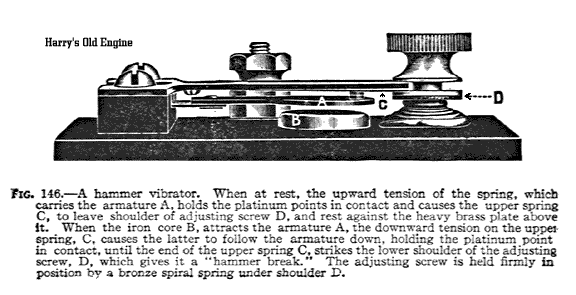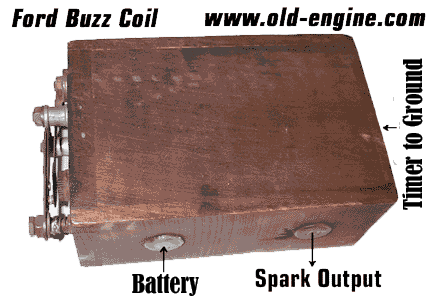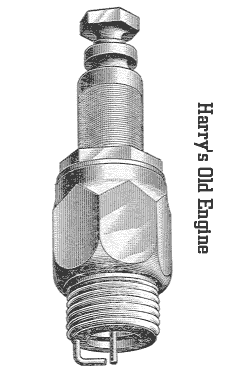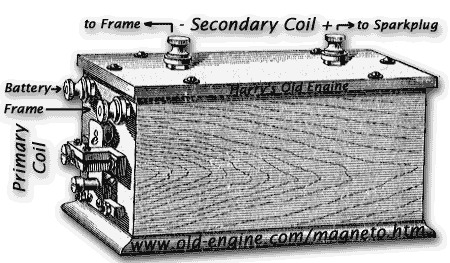
There are two types of COILS used with old engines. Described on another page is the single winding,
low tension coil used with IGNITERS. This one is a high tension coil,
used along with a SPARK PLUG, having TWO windings, a PRIMARY and a
SECONDARY. (This is otherwise known as a TRANSFORMER, converting energy from one
level to another. In this case from low tension to high tension.)The iron core is the same soft iron as
previously discussed to allow for rapid magnetic field collapse. So the primary's job is to build up a
strong magnetic field and then cause it to rapidly collapse.
A means of interrupting the current to cause the rise and fall of the magnetic field is a set of normally closed metal contacts, called a "trembler" that respond to the magnetism in the core. When there is sufficient magnetism to pull the contacts apart, the circuit is opened, then due to the lack of current and magnetic field, the contacts fall shut or closed and the process is repeated. (These points are not inside the combustion chamber and therefore sparking is undesirable.) The noise created by this movement of the contacts is the BUZZ referred to in buzz coils.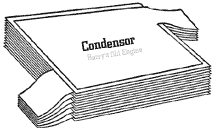
A capacitor or condensor is used across the contacts to aid in the rapid field collapse and to reduce contact arcing thus extending the life of the points. (The condensor absorbs the self-induced current of the primary winding, preventing it from opposing the rapid fall of the primary current.) Early condensors were made up by alternating layers of tin foil and paraffined paper, cut to the same size, like the pages of a book. Even numbered foil sheets were connected together for one polarity and odd numbered sheets were connected together for the opposite polarity. These connections were then routed to each side of the breaker points.
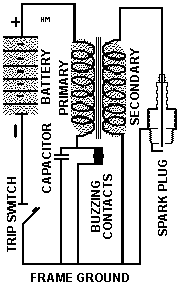
So, here's the line up: a battery, the primary coil, the points and then ground back to the battery through a control (trip) switch. When this TRIP SWITCH calls for a spark, initial current flows in one direction and saturates the iron core. The moving points are then pulled open and the coil discharges. Meanwhile, a SECONDARY winding made up of a great many more turns of finer wire has picked up the rapidly collapsing magnetic field. More turns means more voltage and this voltage is then delivered via an INSULATED wire to a SPARK PLUG. (Finer secondary coil wire means more room for more turns and more voltage, but its higher resistance means less current - it's a trade off. We are looking for STEP-UP transformer action here and therefore few primary turns to many secondary turns.) The spark plug circuit's return path is through the engine casting back to the other side of the secondary coil winding. A high tension magneto works in much the same way except that energy is GENERATED in the coils by magnetic flux in motion rather than by battery power.
See: BUZZ COILS on Ebay!
The ground connects to your engine's iron frame, the spark plug is obvious, but the timer is connected through your battery to the timer switch, which is on the cam shaft of most engines. Whether the points and condensor is on the battery or ground side of the coil may vary from one coil manufacturer to another and shouldn't concern you unless you are rebuilding the coil. In that case, put it back the way you found it. Most of these old coils can be brought back to life simply by cleaning the connections under the terminal bolts. Corrosion makes a great insulator!
The distance between the spark plug points should be from .015 to .025 inches. The insulator inside the base of the spark plug must be kept clean because the electricity from the magneto can leak through the carbon on the insulator instead of jumping across the points, making it hard or impossible to start the engine or making it fire irregularly.
A plug will sometimes show a spark when tested outside of the cylinder and yet fail to fire the engine when replaced in the cylinder. This shows that the plug is "leaky", because of carbon or because the porcelain insulator is cracked. A "leaky" plug will spark outside the cylinder and not inside because the spark can jump through the air easier than it can jump through the compressed charge inside the cylinder, especially when the engine is cold. Trouble is sometimes caused (especially in two cycle engines) by spark plugs that do not extend far enough into the cylinder and thus a pocket is left at the end of the plug in which dead (burnt) gas collects. Such gas can not be fired by any spark. Spark plugs so located tend to carbonize quickly because they operate at too low a temperature.
See additional notes that follow in the summary section. You can make your own BUZZ COIL from easily obtained parts by visiting this link. This method using modern parts, has separate coils - one for stepping up the voltage to feed the spark plug and one to act as the "interrupter" changing the DC battery voltage to pulsating AC. (YMMV) "Your mileage may vary." See the Business Card Page for suppliers of parts for your project.
NEXT PAGE: ![]()
